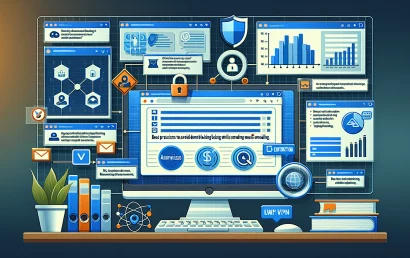What is Domain Warm-up?

In the world of email marketing, the term domain warming refers to the process of gradually establishing a new domain's reputation with email service providers (ESPs). This is a crucial step for businesses that intend to use email campaigns as a part of their marketing strategy. When a new domain is created, it starts with no reputation, meaning that emails sent from that domain are likely to be flagged as spam or not delivered at all. Thus, warming up the domain is essential for ensuring successful email deliverability.
Domain warming involves sending a controlled number of emails over a specific period, gradually increasing the volume and frequency of these emails. This practice helps build trust with ESPs, allowing them to recognize the domain as a legitimate sender. Without proper warming, even the best-crafted email campaigns can fail to reach their intended audience.
The Importance of Domain Warming
Understanding the significance of domain warming is essential for any business planning to engage in email marketing. Without a well-executed warming strategy, companies risk damaging their sender reputation, which can lead to decreased open rates, engagement, and ultimately, revenue.
How Domain Warming Works
The process of warming a domain typically involves several key steps:
“Building a good sender reputation takes time and consistency.”
Initially, businesses should start by sending emails to their most engaged subscribers. This means reaching out to individuals who have previously interacted with the brand. The goal is to demonstrate to ESPs that the emails being sent are wanted and relevant.
Steps to Warm Up Your Domain
Here are some effective strategies for warming up your domain:
- Start Small: Begin by sending a limited number of emails per day, gradually increasing the volume over time.
- Engage with Active Users: Focus on sending emails to users who have opted in and shown interest in your content.
- Monitor Engagement Metrics: Keep an eye on open rates, click-through rates, and bounce rates to gauge the success of your warming efforts.
- Maintain Consistency: Ensure that your sending patterns are consistent, as erratic behavior can raise red flags with ESPs.
By following these steps, businesses can effectively build their domain's reputation and improve their chances of successful email delivery.
Main advantages and disadvantages
Advantages of Domain Warming
Implementing a domain warming strategy comes with several benefits that can significantly enhance the effectiveness of email marketing campaigns:
- Improved Deliverability: A well-warmed domain is more likely to have its emails delivered to the inbox rather than the spam folder, ensuring that your messages reach your audience.
- Enhanced Sender Reputation: Gradually building a positive reputation with email service providers helps establish trust, which is crucial for long-term email marketing success.
- Higher Engagement Rates: By targeting engaged users during the warming process, businesses can boost open and click-through rates, leading to better overall campaign performance.
- Reduced Risk of Blacklisting: A consistent sending pattern minimizes the risk of being flagged or blacklisted by ESPs, which can happen if a new domain sends a high volume of emails too quickly.
Disadvantages of Domain Warming
While domain warming has numerous advantages, it also comes with some drawbacks that businesses should consider:
- Time-Consuming: The warming process takes time and patience, often requiring several weeks to establish a strong sender reputation.
- Requires Strategic Planning: A successful warming strategy necessitates careful planning and execution, which can be challenging for businesses without prior experience.
- Potential for Initial Low Engagement: During the early stages of warming, engagement rates may be lower than expected, which can be discouraging for marketers.
- Limited Immediate Results: Businesses may not see immediate benefits from their email campaigns during the warming phase, as the focus is on building reputation rather than driving sales.
Thematic table
| Aspect | Description | Importance | Best Practices |
|---|---|---|---|
| Domain Warming | The process of gradually establishing a new domain's reputation with email service providers. | Essential for successful email deliverability. | Start with a small number of emails and gradually increase volume. |
| Sender Reputation | A measure of how trustworthy a sender's domain is, based on user engagement and email practices. | Directly impacts email deliverability and engagement rates. | Maintain consistent sending patterns and focus on engaged users. |
| Email Service Providers (ESPs) | Companies that offer email marketing services and manage email delivery. | They assess sender reputation to determine email deliverability. | Understand the guidelines and best practices of major ESPs. |
| Engagement Metrics | Data points that measure how recipients interact with your emails, including open rates and click-through rates. | High engagement metrics indicate a positive sender reputation. | Regularly monitor and analyze engagement metrics to adjust strategies. |
| Blacklisting | A situation where a domain is flagged by ESPs, resulting in emails being blocked or sent to spam. | Can severely impact email marketing efforts and sender reputation. | Follow best practices to avoid being blacklisted; monitor domain health. |
| Warming Schedule | A planned timeline for gradually increasing email volume during the warming process. | Helps ensure a steady build-up of sender reputation. | Create a detailed schedule outlining daily and weekly email volumes. |
| Target Audience | The group of individuals who receive your emails, ideally those who have opted in. | Engaging with an active audience improves reputation and metrics. | Segment your audience to target the most engaged users first. |
| Monitoring Tools | Software or services used to track email performance and sender reputation. | Essential for evaluating the effectiveness of warming strategies. | Utilize tools that provide insights into deliverability and engagement. |
Let's summarize the category:
Domain warming is a critical process for any business looking to engage in effective email marketing. By gradually establishing a new domain's reputation with email service providers, companies can ensure that their emails reach the intended audience, rather than being lost in spam folders. This process not only enhances deliverability but also builds trust and credibility over time.
Key advantages of domain warming include improved deliverability, enhanced sender reputation, and higher engagement rates. By starting small and focusing on engaged users, businesses can create a solid foundation for future email campaigns.
“A well-executed domain warming strategy is essential for long-term success in email marketing.”
However, it's important to acknowledge the challenges associated with this process. Domain warming can be time-consuming and requires careful planning. Businesses may face initial low engagement rates and may not see immediate results, which can be discouraging.
Overall, understanding the nuances of domain warming, including its advantages and potential drawbacks, is essential for marketers. By implementing best practices and monitoring performance metrics, businesses can effectively navigate the warming process and set the stage for successful email marketing campaigns.





